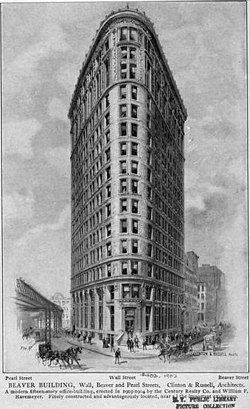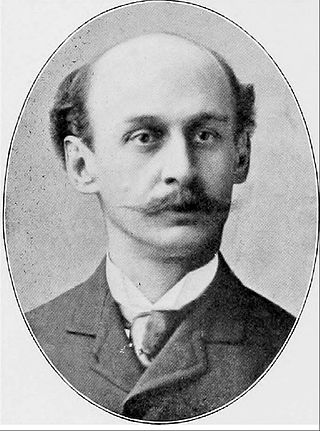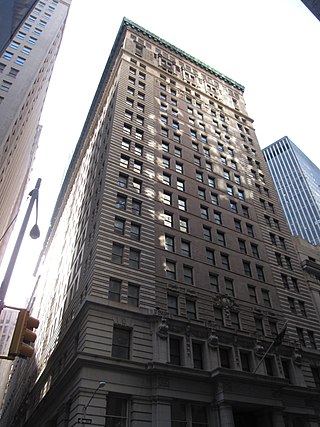



Clinton and Russell was a well-known architectural firm founded in 1894 in New York City, United States. The firm was responsible for several New York City buildings, including some in Lower Manhattan.




Clinton and Russell was a well-known architectural firm founded in 1894 in New York City, United States. The firm was responsible for several New York City buildings, including some in Lower Manhattan.
Charles W. Clinton (1838–1910) was born and raised in New York and received his formal architectural training in the office of Richard Upjohn. He left Upjohn in 1858 to begin a private practice, and from then through 1894 he conducted his own significant career, the highpoint of which was probably the 1880 Seventh Regiment Armory.
William Hamilton Russell (1856–1907) was born in New York City as well. He attended the Columbia School of Mines before he joined his great uncle, James Renwick, in his architecture firm in 1878. At Columbia, Russell had been a member of St. Anthony Hall, the secret fraternal college society, and within a year of his joining his great uncle's firm, in 1879, Renwick completed the first St. A's Chapter House, at 25 East 28th Street, likely with Russell involved in the design work. [1]
In New York City's ambitious building boom c. 1900, Clinton and Russell were responsible for designing the world's largest apartment building, the world's largest office building, and a cluster of early downtown skyscrapers along Broadway and Wall Street for banks and insurance companies. Many of the firm's important commissions related to real estate investments of the Astor family. The landmark Astor Hotel that served as an anchor for the development of Times Square, the Astor Apartments, the Graham Court Apartments, and The Apthorp were among their projects for William Waldorf Astor, 1st Viscount Astor. Stylistically, much of their work conformed to a conservative Italian Neo-Renaissance style. [2]
After the deaths of the principals, the firm continued in business, and in 1926 it was renamed Clinton Russell Wells Holton & George (and variations of that name). For a time the English-born Colonel James Hollis Wells (1864-1926) headed the organization; the Lillian Sefton Dodge Estate on Long Island is his design. The firm remained in existence until 1940.
One of the firm's earliest employees was Abraham H. Albertson, who started there as a draftsman and went on to be a prolific architect in Seattle. [3]

George Browne Post, professionally known as George B. Post, was an American architect trained in the Beaux-Arts tradition. Active from 1869 almost until his death, he was recognized as a master of several prominent contemporary American architectural genres, and instrumental in the birth of the skyscraper.

James Renwick Jr. was an American architect in the 19th century, noted especially for designing churches and museums. The Encyclopedia of American Architecture calls him "one of the most successful American architects of his time".

Henry Janeway Hardenbergh FAIA was an American architect, best known for his hotels and apartment buildings, and as a "master of a new building form — the skyscraper." He worked three times with Edward Clark, the wealthy owner of the Singer Sewing Machine Company and real estate developer: The Singer company's first tower in New York City, The Dakota Apartments, and its precursor, the Van Corlear. He is best known for building apartment dwellings and luxury hotels.

Carrère and Hastings, the firm of John Merven Carrère and Thomas Hastings, was one of the outstanding American Beaux-Arts architecture firms. Located in New York City, the firm practiced from 1885 until 1929, although Carrère died in an automobile accident in 1911.

Francis Hatch Kimball was an American architect practicing in New York City, best known for his work on skyscrapers in lower Manhattan and terra-cotta ornamentation. He was an associate with the firm Kimball & Thompson. His work includes the Empire Building, Manhattan Life Insurance Building, and Casino Theatre. All but one of Kimball's work was in the United States.

Trowbridge & Livingston was an architecture firm based in New York City, active from 1897 to 1925. The firm's partners were Breck Trowbridge and Goodhue Livingston. They were successors to the firm Trowbridge, Colt & Livingston, founded in 1894 but dissolved in 1897 when Stockton B. Colt left the partnership.

Hotel Astor was a hotel on Times Square in the Midtown Manhattan neighborhood of New York City, United States. Built in 1905 and expanded in 1909–1910 for the Astor family, the hotel occupied a site bounded by Broadway, Shubert Alley, and 44th and 45th Streets. Architects Clinton & Russell designed the hotel as an 11-story Beaux-Arts edifice with a mansard roof. It contained 1,000 guest rooms, with two more levels underground for its extensive "backstage" functions, such as the wine cellar.

1 Wall Street Court is a residential building in the Financial District of Manhattan in New York City, United States. The 15-story building, designed by Clinton and Russell in the Renaissance Revival style, was completed in 1904 at the intersection of Wall, Pearl, and Beaver Streets.

The Apthorp is a condominium building at 2201–2219 Broadway on the Upper West Side of Manhattan in New York City, United States. The 12-story structure was designed by Clinton & Russell in the Italian Renaissance Revival style and occupies the full block between Broadway, West End Avenue, and West 78th and 79th Streets. It was built between 1905 and 1908 as a residential hotel by William Waldorf Astor, who named it after the Apthorp Farm, of which the site used to be part. The Apthorp is a New York City designated landmark and is listed on the National Register of Historic Places.

Walker & Gillette was an architectural firm based in New York City, the partnership of Alexander Stewart Walker (1876–1952) and Leon Narcisse Gillette (1878–1945), active from 1906 through 1945.

The Broad Exchange Building, also known as 25 Broad Street, is a residential building at Exchange Place and Broad Street in the Financial District of Lower Manhattan in New York City. The 20-story building was designed by Clinton & Russell and built between 1900 and 1902. The Alliance Realty Company developed the Broad Exchange Building as a speculative development for office tenants.

The Apthorp Farm that lay on Manhattan's Upper West Side straddled the old Bloomingdale Road, laid out in 1728, which was re-surveyed as The "Boulevard" – now Upper Broadway. It was the largest block of real estate remaining from the "Bloomingdale District", a rural suburb of 18th-century New York City. Legal disputes between the eventual heirs of the Loyalist Charles Ward Apthorp and purchasers of parcels of real estate held in abeyance the speculative development of the area between 89th and 99th Streets, from Central Park to the Hudson River until final judgment was awarded in July 1910; at that time the New York Times estimated its worth at $125,000,000.
Marc Eidlitz was a builder active in New York City, where he was prominent in the construction industry, in partnership with his son Otto Eidlitz (1860–1928).

Schickel & Ditmars was an architectural firm in New York City, active during the city's Gilded Age from 1885 until the early 1900s. It was responsible for designing many fine churches, residences and commercial buildings.

Hubert, Pirrson & Company was a New York City architectural firm, founded by Philip Gengembre Hubert (1830–1911) and James W. Pirrson (1833–1888), which was active from c.1870 to 1888. It was later known as Hubert, Pirsson and Company, and Hubert, Pirrson & Haddick from 1888-1898. Active during New York City's "Gilded Age", the firm produced many of the city’s finest buildings, including hotels, churches and residences, and were especially noted for their luxury co-operative apartments and residential hotels.

Barnett, Haynes & Barnett was a prominent architectural firm based in St. Louis, Missouri. Their credits include many familiar St. Louis landmarks, especially a number related to the local Catholic church. Their best-known building is probably the Cathedral Basilica of St. Louis. A number of the firm's works are listed on the U.S. National Register of Historic Places.
Harry B. Mulliken was an early twentieth-century American architect and developer who built many of his works in New York City. Mulliken's apartment and hotel buildings are remarkable for their Beaux-Arts-style and broad use of architectural terra cotta set around flat, and often red, brick.
Edgar Joachim Moeller was an early twentieth-century American architect who partnered with Harry Mulliken to build several apartment hotels in New York City. The partnership's Beaux-Arts style is distinguishable and makes a similarly broad use of architectural terra cotta set around flat brick.

The Astor is a building at 235 West 75th Street, on Broadway between 75th and 76th Streets, on the Upper West Side of Manhattan in New York City. William Waldorf Astor hired architects Clinton and Russell to design the two southern towers of The Astor in 1901. In 1914, William Waldorf Astor hired Peabody, Wilson & Brown to design a third tower for The Astor. The third tower, completed within a year, is structurally and aesthetically similar to both original towers. All three wings are connected at the base and have gray brick facades above a limestone base. The buildings are also distinguished by limestone quoins.

Montrose W. Morris was an American architect from Brooklyn best known for some of the first multi-unit apartment buildings in New York City. His most well-known buildings include the Alhambra Apartments, Imperial Apartments, and the Renaissance Apartments all in Brooklyn, New York. Most of Morris’ work still stands adding greatly to the borough's architectural heritage. Morris worked in the prevalent architectural styles of the period, including Queen Anne and Romanesque Revival.